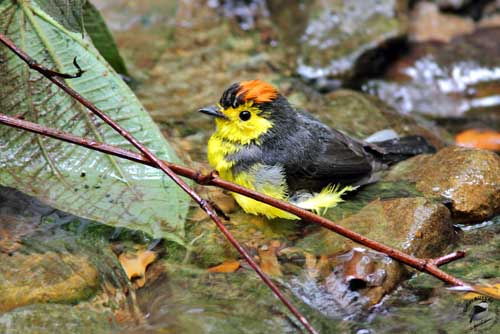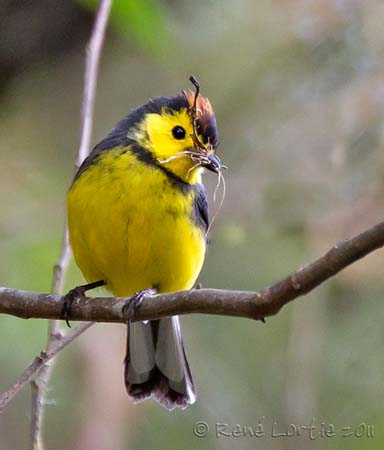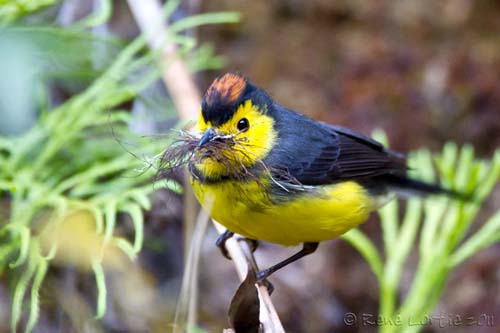
Fr: Paruline ceinturée
All : Halsband-Waldsänger
Esp : Candelita Acollarada
Ital : Parula pigliamosche dal collare
Nd: Halsbandzanger
Sd: Halsbandsvitstjärt
Photographers:
Didier Buysse
Vision d’Oiseaux
René Lortie
http://rlortie.ca/
Text by Nicole Bouglouan
Sources:
HANDBOOK OF THE BIRDS OF THE WORLD Vol 15 by Josep del Hoyo-Andrew Elliot-David Christie - Lynx Edicions – ISBN: 9788496553682
THE HANDBOOK OF BIRD IDENTIFICATION FOR EUROPE AND THE WESTERN PALEARCTIC by Mark Beaman, Steve Madge - C. Helm - ISBN: 0713639601
BirdLife International (BirdLife International)
Neotropical Birds – Cornell Lab of Ornithology
Wikipedia, the free encyclopaedia
Collared Redstart
Myioborus torquatus
Passeriforme Order – Parulidae Family
BIOMETRICS:
Length: 13 cm
Weight: 10, 5 g
DESCRIPTION:
The genus Myioborus includes the tropical New World warblers. The Collared Redstart is often called “whitestart” too.
The Collared Redstart has dark blue-grey uniform upperparts, with some greenish glossy feathers on lower back and upper rump. The underparts are bright yellow, mostly whitish on vent and undertail-coverts. We can see a dark blue-grey band between throat and upper breast. The tail is blackish-grey with white outer feathers.
On the head, there is a conspicuous bright reddish patch on crown, bordered by a narrow black stripe, except on the hindcrown. Face, lores, cheeks and throat are bright yellow. The nape is grey.
The thin bill is pointed and blackish. The eyes are dark brown. Legs and feet are greyish-black.
Both sexes are similar. The juvenile is darker, with dark greyish head, throat, breast and upperparts with brownish wash. The underparts are pale yellowish.

VOICE: SOUNDS BY XENO-CANTO
The Collared Redstart’s call is a thin and dry “tzip”.
The song is a series of monotonous, ringing and rapid notes “tsi-tsi-tsi-tsi-tsi…” with trills and warbles often mixed.
HABITAT:
The Collared Redstart lives in high elevation oak forests and edges, brushy ravines and highland pastures, from 1500 metres of elevation up to the treeline. But this species can be seen higher, up to 2200-2500 metres according to the range.
RANGE:
The Collared redstart has a very small distribution, from N Costa Rica to WC Panama.
BEHAVIOUR:
The Collared Redstart feeds mainly on insects and forages at all levels, including high in trees, by gleaning and flycatching. It performs sallies to catch insects disturbed by birds and other animals. It can be seen following cattle in pastures, and it may even follow humans in order to catch some insects scared up by the steps.
It also forages through the trees and under leaves, searching for insects.
It often flicks and fans its tail while foraging, showing its conspicuous white outer feathers. The wings are dropped.
This behaviour could be used to disturb insects which are followed and caught in flight once flushed.

This species is primarily sedentary, only performing some altitudinal movements during the non-breeding season. It reaches lower areas towards the end of the rainy season.
FLIGHT:
The Collared redstart has an agile flight, performing short flights from trees to the ground and back. It pursues easily the flying insects.
REPRODUCTION:
The breeding season occurs between March and May.
The Collared Redstart builds a domed nest with a side entrance. This structure is made with plant fibres, scales of tree-ferns and dry bamboo leaves. The nest is on the ground, concealed in grassy bank or under rock or fallen dead tree.
The female lays 2-3 white to creamy eggs finely speckled brown. The incubation lasts about 13-14 days. The chicks are fed by both parents, and probably depend on adults for some weeks more after fledging.
DIET:
The Collared Redstart feeds mainly on insects.
PROTECTION / THREATS / STATUS:
The Collared Redstart has restricted range but the species is common throughout its habitat.
Populations are not globally threatened.
